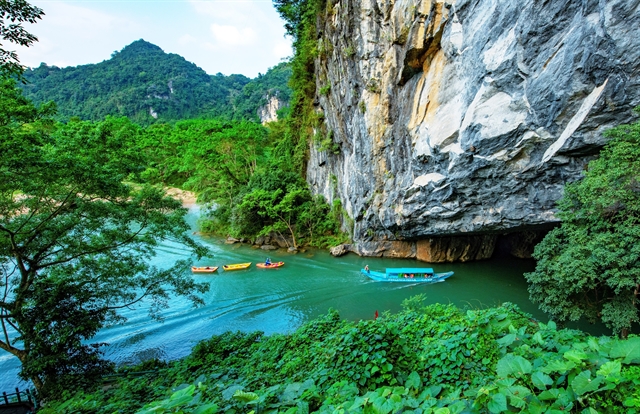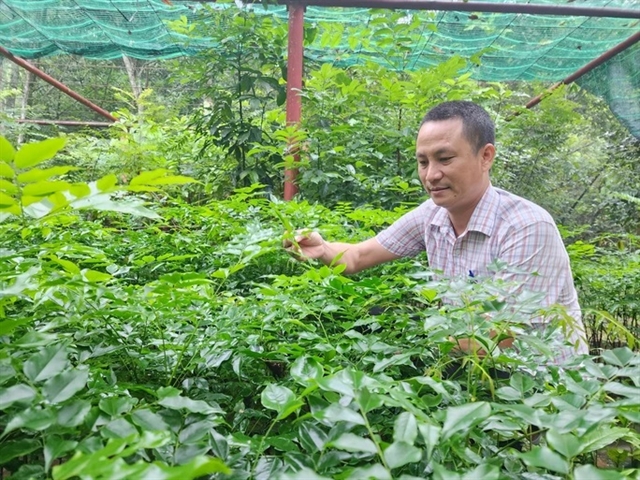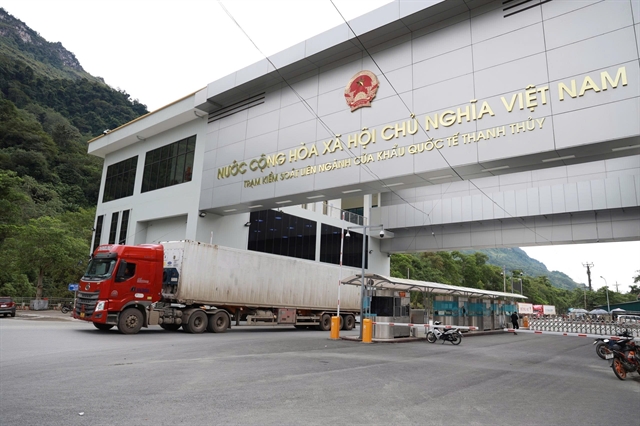 Environment
Environment

 |
| Phong Nha – Kẻ Bàng National Park in the central coastal province of Quảng Bình. — VNA/VNS Photo |
QUẢNG BÌNH — Lê Thuận Kiên takes a basket, carrying a machete and some food and drinks, then follows a familiar road to the jungle in Phong Nha – Kẻ Bàng National Park in the central coastal province of Quảng Bình.
Kiên, head of Organism Research and Conversation Office, under the national park’s Centre for Rescue, Conservation and Creature Development, and his colleagues, often spend time in the park’s dense forest to find and preserve rare and endangered plant species.
These activities have strengthened the conservation, propagation and growing of indigenous plants and medicinal herbs.
This time, Kiên and his colleagues entered the jungle and climbed a limestone mountain at the border commune of Tân Trạch Commune, Bố Trạch District, to look for bách xanh đá (Calocedrus rupestris Aver.) – a rare and ancient plant species listed in Việt Nam’s Red Book.
Bách xanh đá was discovered in the national park in 2005. The tree is in danger of extinction globally. It often takes root on ancient Karst cliffs, hidden among the clouds at up to a thousand metres in altitude on the park’s limestone ranges.
Kiên and his colleagues had to spend a whole day climbing towering cliffs and slippery rotten tree trunks, reports Người lao động (The Labourer) online newspaper.
Many trees here are up to 500 years old, with trunks so big that two people could not reach around them.
Kiên said because the trees were extremely rare, the centre was very interested in researching, propagating and preserving the species.
The trees are propagated by seeds or branches. If they find young trees, Kiên and his colleagues would bring them to the centre to take care of them, he said.
However, as it is unusual to find young trees, they often propagate them from branches.
“We cut the branches, bring them to the centre and soak them in rooting hormone.”
The process can last about one year. After the tree has roots, they will plant it and care for it.
But the rate of tree rooting was very low, only about 20 per cent of the branches that they took from the jungle, Kiên said.
“Thus, preserving the trees is very hard,” he said.
Trần Mừng, one of Kiên’s colleagues, said he already spent more than 10 years wandering in the jungle looking for rare native tree varieties.
Recently, Mừng and his colleagues climbed the steep mountain peaks to get phong lá quế (Acer laurinum) seedlings for propagation.
According to the centre, finding and propagating rare native plants in the national park is extremely strenuous, difficult and dangerous, and takes years of working in the forest to be successful.
Nursery
 |
| Tourists at the botanic garden in Phong Nha – Kẻ Bàng National Park in the central coastal province of Quảng Bình. — Photo nld.com.vn |
The botanic garden of the centre is considered to be a nursery for the forest.
There are hundreds of rare plant species here, many of them being typical native trees, including sưa (Dalbergia tonkinensis), lim xanh (Erythrophleum fordii Oliver), bách xanh đá (Calocedrus rupestris Aver.) and dổi (Michelia tonkinensis A. Chev).
Some plant species here have high medicinal value, such as bò khai (Erythropalum scandens Blume), chè dây (Ampelopsis cantoniensis) and giảo cổ lam (Gynostemma pentaphyllum).
The botanic garden is also a nursing station for rare plant species obtained from loggers. The garden has a special area to take care of rare orchids.
After the orchids are carefully cultivated, they will be returned to the natural environment.
The centre was preserving plant species using two main methods of cuttings and phenology, Kiên said.
Trần Ngọc Anh, deputy director of the centre, said that the botanic garden had bred and produced 60,000 native plants of 124 species to serve the conservation of plants of the forest over the past decade.
Recently, the garden successfully propagated five rare native tree species classified as endemic species, including re gừng (Cinnamomum bejolghota), sưa (Dalbergia tonkinensis), dầu rái (Dipterocarpus alatus), gụ lau (Sindora tonkinensi), and vàng anh (Saraca dives), he said.
This was the result of the tireless efforts of all officers and staff in the national park over the past time.
Anh said thanks to these efforts, new prospects in the conservation of genetic resources of rare plant species in the national park had been opened up.
 |
| Rare native plants are cultivated at Phong Nha Kẻ Bàng botanic garden. — Photo nld.com.vn |
“This is also the motivation for the centre's staff to continue research and propagate many other rare plant species,” he added.
Phong Nha-Kẻ Bàng National Park in the central coastal province of Quảng Bình has a core area of 85,754 ha. The national park is known for its limestone formations, 300 caves, underground rivers, and rare flora and fauna listed in the Việt Nam Red Book and the International Union for Conservation of Nature Red List of Threatened Species (Red Data Book).
The park has twice earned United Nations Educational, Scientific and Cultural Organisation (UNESCO) recognition, first as a World Natural Heritage for exceptional global value in geology and geomorphology, and again for its biodiversity and ecology. — VNS




